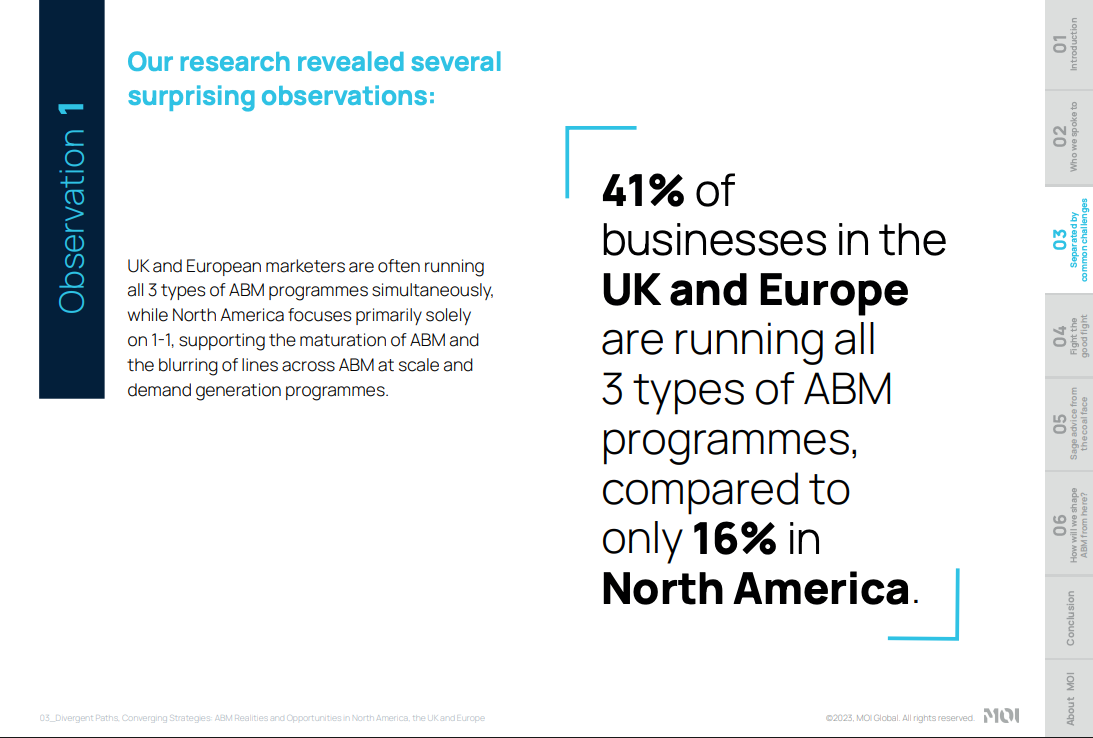Running Account-Based Marketing (ABM) in Europe isn’t just about adapting what works in the U.S. The rules, culture, and data realities are completely different. What scales in large, unified markets often falls apart in Europe’s mosaic of more than 40 countries, each with unique languages, regulations, and buying behaviors.
To succeed, marketers need a European playbook built on localization, compliance, and trust. Between GDPR restrictions, fragmented media ecosystems, and slower decision cycles, success depends on precision, consent-first data collection, and regionally resonant storytelling.
Why does ABM in Europe require a different strategy than in the U.S. and other regions?
Running ABM in Europe isn’t just a change of geography. It’s a shift in mindset, regulation, and execution. What works in large, unified markets often fails in Europe’s complex landscape.
To succeed with their ABM programs, senior and revenue-oriented marketers need to understand not only what to do differently, but why Europe’s buying environment demands it.
Privacy, Consent-First Culture, and Limited Person-Level Targeting
In the U.S., marketers thrive on person-level data, hyper-targeted outreach, and large contact databases. In Europe, GDPR changes that play entirely. The fine for GDPR violation can go up to 4% of the annual global revenue of a company or 20 million EUR, whichever will be higher. But of course, if no fine applies, organizations can still be punished via warnings, reprimands, and corrective orders.
Personal data including professional contact information is heavily protected, forcing teams to shift toward first-party, consent-based insights and account-level targeting.
A FoundryCo ABM Benchmark Study found that while 82% of European B2B marketers report ABM success, one in three have less than a year of hands-on experience. The region’s ABM maturity is still growing, which makes trust and compliance key differentiators rather than afterthoughts.
What this means for you:
- Prioritize consent-first signals
- Focus on account-level engagement whenever you don’t have consent from an individual to process their data
- Work only with vendors that demonstrate EU-compliant data handling across sourcing, storage, and processing.
Fragmented Markets, Multiple Languages, and Cultural Nuance
Europe is not a single market. Messaging that performs well in Germany may fall flat in Spain. Even tone and visual style can shift from one region to another.
This diversity demands flexibility and sensitivity. Not just translation, but localization at every layer of your ABM program.
In their European expansion playbook, Cognism team mentioned, “we wish International expansion were as easy as replicating your existing playbooks in a new region… [but] there are too many differing factors at play. And we learned it the hard way”.
Research shows that 41% of European marketers use all three ABM types (one-to-one, one-to-few, and one-to-many), compared to only 16% in North America. This reflects Europe’s experimentation mindset and the need for tailored strategies by region.

- Localize campaigns by language, tone, and cultural relevance
- Segment your audiences by region (DACH, Benelux, Nordics, Southern Europe)
- Partner with vendors that have proven local execution experience
- Understand and comply with additional privacy frameworks such as ePrivacy
Without localization, even the strongest value proposition risks being ignored. ABM in Europe is about resonance.
Media Habits and Outreach Norms
European buyers expect outreach that feels earned, not automated. Cold emails and mass contact scraping aren’t just frowned upon. They break trust instantly.
Instead, successful European ABM programs lean into brand building, thought leadership, and regionally relevant engagement.
According to Forrester, most teams in Europe report noticeably longer nurture cycles, especially in markets like Germany and the UK. This is why campaigns that combine awareness-building with education-driven content tend to perform better in the region: buyers need more context, more clarity, and more proof before they move.

The takeaway:
ABM in Europe is slower, but deeper. It’s about nurturing relationships through consistent visibility across local media, events, and community-led platforms rather than aggressive outreach sequences.
Larger Buying Committees and Slower Decision Cycles
European deals often involve more stakeholders, more steps, and longer timelines. Decision-making is consensus-based and risk-averse, requiring teams to build sustained trust rather than quick wins.
Studies show European marketers are less confident than their U.S. counterparts in accelerating deal velocity, citing alignment and account prioritization as ongoing challenges.
The practical move:
- Map the entire buying committee, not just key decision-makers
- Keep marketing, sales, and customer success tightly aligned from day one
- Measure progress by engagement and influence across the buying group, not just conversion speed
Longer cycles can be frustrating, but they also build stronger customer relationships and more predictable revenue over time.
Operational and Organizational Challenges
Even mature teams struggle to scale ABM effectively across European markets. Success here requires operational maturity, cross-functional coordination, and regional adaptability.
Data fragmentation and compliance risk
GDPR and national privacy laws make person-level targeting difficult. Teams must balance accuracy and reach while maintaining strong governance around consent and data use.
Language and cultural diversity
Messaging that resonates in one country can feel disconnected in another. Without localization and empathy, campaigns lose relevance and credibility.
Limited regional intent data coverage
Many U.S.-centric intent vendors lack the scale or consent alignment needed for European markets, creating blind spots in engagement and targeting.
Longer buying cycles and complex committees
Deals take time. Success depends on sustained awareness, trust-building, and alignment between marketing, sales, and customer success.
Central vs. local execution gaps
Global strategies often break down when not adapted locally. European teams need autonomy, flexible campaign frameworks, and transparent data to execute effectively.
What should you look for when choosing an ABM vendor in Europe?
Given those unique European requirements, how do you pick a vendor that genuinely works for Europe and not just a global platform that treats Europe as an afterthought?
Here’s a checklist + best practices, plus a look at the tech stack you should expect and evaluate.
Vendor Selection Checklist
- Data sourcing & compliance transparency
- Ask: How do you collect your contacts/data? Are EU-resident decision-makers included? What legal basis is used (consent, legitimate interest)?
- Ask: Where is the data hosted? Is there EU-only storage? How are transfers outside the EU handled?
- Ask: How do you enrich, match, link data at account-level vs individual-level?
- If the vendor can’t clearly explain their European-governance model, you’ve got risk.
- Regional/localised capability
- Does the vendor have language support (German, French, Spanish, Nordic, etc)?
- Do they segment campaigns by country/regional market?
- Do they have case-studies in DACH, Benelux, Nordics, Southern Europe and not just UK/US?
- Can they handle localisation of content, messaging, media buys per market?
- Channel diversity & full-funnel support
- Does the vendor support the full buyer journey: awareness → interest → decision (for Europe) and not just “target + outreach”?
- Do they support multiple channels (display, native, local media, events/webinars, account-based display) in European contexts?
- Do they build in nurturing sequences for slower cycles and multi-persona engagements?
- Measurement, reporting & attribution aligned to Europe
- Are KPIs tied to pipeline and revenue (especially given longer cycles), not just “leads” or “meetings”?
- Are they able to show performance in Europe, not only U.S. metrics?
- Do they understand longer sales cycles, larger committees, and track accordingly? (See reports on EMEA ABM maturity and challenges. )
- Flexibility & cultural alignment
- Do they treat Europe as more than “Europe = one region”?
- Are they willing to adapt their playbook (and coach you) rather than force a U.S. playbook?
- Do they provide strategic guidance on European market behaviour, not simply tool support?
-
- Do they have a local customer success team?
ABM Vendor Tech Stack for Europe
A strong European ABM stack should include:
- Data and Account Identification: GDPR-compliant data enrichment and intent insights
- Audience Segmentation: Regional ICPs, firmographic and behavioral filters
- Orchestration Layer: Multi-channel execution and localized messaging
- Engagement and Nurture: Long-cycle workflows for multi-persona journeys
- Measurement and Attribution: Pipeline and revenue visibility across regions
- Integration and Compliance: Seamless CRM and MAP sync with EU-hosted storage
- Localization Support: Language, regional channels, and culturally aware creative
Practical Framework for ABM in Europe
-
Start with compliance as a design principle
- Build from GDPR outward. Use first-party intent signals, contextual targeting, and account-level engagement instead of third-party databases.
- Choose platforms that host data within the EU and can document every data flow.
-
Localise every layer of your strategy
- Adapt ICPs per region (Nordics ≠ DACH ≠ Southern Europe).
- Create language-specific value propositions and adapt creative assets for tone, media, and culture.
-
Build hybrid awareness and trust campaigns
- Mix digital ABM (account-based display, paid social, retargeting) with offline and experiential marketing (events, webinars, local partnerships).
- Prioritise awareness and education before conversion. European buyers value brand trust and thought leadership.
-
Align marketing, sales, and customer success across regions
- Define account hierarchies and territory management that reflect Europe’s cross-border business relationships.
- Set unified reporting but allow local customisation of KPIs (pipeline velocity, engagement depth, account coverage).
-
Measure patience as a metric
- European ABM success is a long-cycle: Track multi-touch engagement and reputation growth over time, not just lead conversions.
If ABM in the U.S. is about precision and speed, ABM in Europe is about connection and credibility. Those who master both, global scale with local authenticity, are the ones who win.




.webp)
.webp)